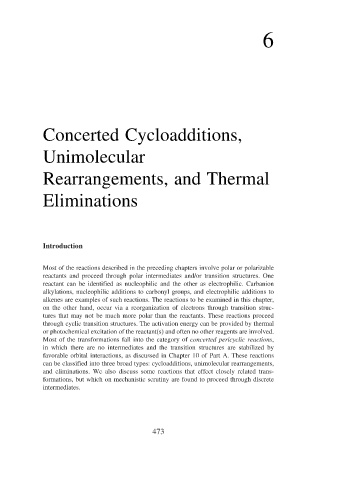Page 499 - Advanced Organic Chemistry Part B - Reactions & Synthesis
P. 499
6
Concerted Cycloadditions,
Unimolecular
Rearrangements, and Thermal
Eliminations
Introduction
Most of the reactions described in the preceding chapters involve polar or polarizable
reactants and proceed through polar intermediates and/or transition structures. One
reactant can be identified as nucleophilic and the other as electrophilic. Carbanion
alkylations, nucleophilic additions to carbonyl groups, and electrophilic additions to
alkenes are examples of such reactions. The reactions to be examined in this chapter,
on the other hand, occur via a reorganization of electrons through transition struc-
tures that may not be much more polar than the reactants. These reactions proceed
through cyclic transition structures. The activation energy can be provided by thermal
or photochemical excitation of the reactant(s) and often no other reagents are involved.
Most of the transformations fall into the category of concerted pericyclic reactions,
in which there are no intermediates and the transition structures are stabilized by
favorable orbital interactions, as discussed in Chapter 10 of Part A. These reactions
can be classified into three broad types: cycloadditions, unimolecular rearrangements,
and eliminations. We also discuss some reactions that effect closely related trans-
formations, but which on mechanistic scrutiny are found to proceed through discrete
intermediates.
473

